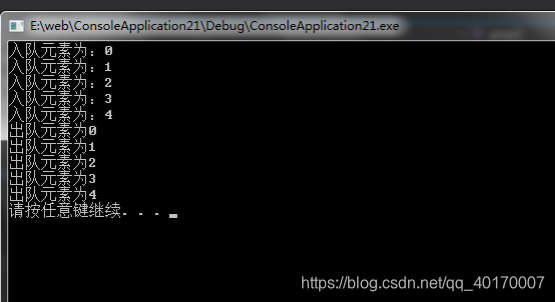一、使用两个栈实现一个队列(栈s1,s2)
入队操作:入栈操作,count+1;
出队操作:s1出栈,入栈s2,出栈s2
具体实现代码:
#include<iostream>
#include<stack>
using namespace std;
//利用两个栈实现一个队列
template<class T>
class MyQue{
private:
int count;
stack<T> s1;
stack<T> s2;
public:
MyQue():count(0){}
void push(T elem){
s1.push(elem);
cout<<"入队元素为:"<<elem<<endl;
count++;
}
void change(){//将栈转化成队列的成员函数
for(int i=0;i<count;i++){
T tmp=s1.top();
s1.pop();
s2.push(tmp);
}
}
void pop(){
cout<<"队首元素为"<<s2.top()<<endl;
s2.pop();
count--;
}
};
int main(){
MyQue<int> q;
for(int i=0;i<5;i++){
q.push(i);
}
q.change();
for(int j=0;j<5;j++){
q.pop();}
system("pause");
return 0;
}运行结果:

二、使用队列来实现栈
入栈操作:入队操作
出栈操作:将前count-1个元素先出队再入队,最终将队尾元素移到了队首,就可以出队啦
实现代码:
#include <iostream>
#include <queue>
#include <list>
#include <deque>
using namespace std;
template<class T>
class MyStack{
private:
int count;
queue<T> MyQueue;
public:
MyStack():count(0){}
void Push(T elem){
MyQueue.push(elem);
count++;
}
void Pop(){//出栈操作,先将前n-1个元素出队,再入队,最后再执行一次让第n的元素出队
int i;
T tmp;
for(i=0;i<count-1;i++){
tmp=MyQueue.front();
MyQueue.pop();
MyQueue.push(tmp);
}
MyQueue.pop();
count--;
}
int top(){
return MyQueue.back();
}
};
int main(){
MyStack<int> s;//创建类的对象
int num;
for(int i=1;i<5;i++){
s.Push(i);
}
for(int j=1;j<5;j++){
num=s.top();
s.Pop();
cout<<"栈顶元素为"<<num<<endl;;
}
system("pause");
return 0;
}
实现结果:
